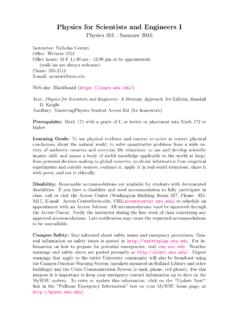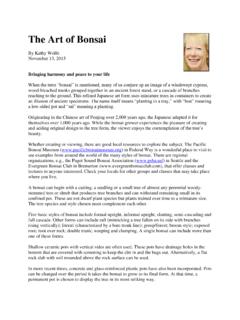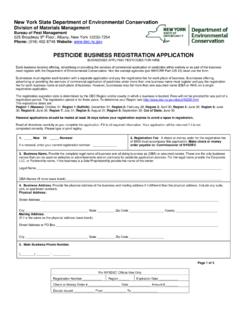Transcription of miracle, myth…or marketing - Washington State University
1 SPRING 2007 MASTERGARDENER PAGE 3 With the increased consumer interest in managing gardens and land-scapes sustainably, products are likewise being marketed as safe and natural. Epsom salts, also known as magnesium sulfate (MgSO4), is touted as one of the most perfect nutrients for gardens and plants. Numerous claims are made to its eff ectiveness in increasing seed germination, improving uptake of other nutrients, and enhancing growth and overall health. Tried and true tips are provided, which include specifi c formulations for houseplants, vegetables, turf , shrubs, and trees. Dangers of nutrient overload are minimized by assurances that Epsom salts is not persistent so you can t overuse it. Th e RealityEpsom salts has been used to relieve magnesium defi ciency found during intensive cropping of many fruit and vegetable species worldwide. Th ese include commonly grown North American crops such as alfalfa, apple, beets, carrots, citrus, caulifl ower, cotton, grains, hops, kale, nuts, okra, peppers, plums, potatoes, snap beans, sugar beets, sweet potatoes, tobacco, tomatoes, watermelon, and wine grapes, as well as more exotic species including banana, cacao, coff ee, rubber, Swedish turnips, and tea.
2 Conifer species grown for timber use have also been treated with Epsom salts under magnesium-defi cient the diverse plant materials that have been studied under treatment with Epsom salts, there are two commonalities: all are intensively produced crops and all were suff ering from magnesium defi ciency. It is important to keep these two points in mind as we examine the claims and recommendations regarding Epsom salt use in the of defi ciencyTh ere are two primary causes of magnesium defi ciency in plants: an actual lack of soil magnesium, or an imposed defi ciency caused by mineral imbalances in the soil or plant. Magnesium defi ciencies most commonly occur in soils described as light, sandy, and/or acid, though occasionally clay soils under intensive production can show magnesium defi ciency as well. Regardless of type, soils heavily leached by rainfall or irrigation are more likely to exhibit magnesium defi ciency.
3 Th us, soil addition of highly soluble Epsom salts under leaching conditions does not benefi t magnesium-defi cient plants but does increase mineral contamination of water passing levels of potassium contribute to a mineral imbalance that causes magnesium defi ciency in a variety of species, even when soil levels of magnesium are adequate. High levels of soil potassium apparently interfere with root uptake of magnesium. Addition of nitrogen and/or reduction of available potassium are both recommended to overcome this indirect magnesium defi ciency; trees high in nitrogen were found to be less susceptible to magnesium defi ciency than those with reduced nitrogen the claimsCLAIM: ..unlike most commercial fertilizers, which build up in the soil over time, Epsom Salt is not persistent, so you can t overuse it. miracle, marketingEpsom saltsM O R E I N F O R M AT I O NDr.
4 Chalker-Scott has additional columns on numerous science-based topics at this carefully edited Web ~Linda%20 Chalker-Scott/Dr. Chalker-Scott has additional carefully edited Web site:Wscapes sustainably, products are likewise being marketed as safe and natural. Epsom salts, also known as magnesium sulfate Linda Chalker-Scott, WSU editorExtension Urban Horticulturist and Associate Professor, Puyallup Research and Extension Center, Washington State UniversityPuyallup, WashingtonSeveral researchers have expressed concern with possible toxicities associated with excessive applications of Epsom salts. Most commonly, Epsom salt solutions have been sprayed on foliage, resulting in leaf scorch. (Inclusion of a wetting agent can relieve this.) Excessively applied Epsom salts was also linked to root disease of sugar cane grown on clay soils, and with increased incidence of apple bitter pit.
5 One researcher directly contradicts the above statement, finding instead that, Magnesium residues from fertilizer unused by plants accumulate in the topsoil and are not rapidly removed by leaching. Unfortunately, this evidence is generally ignored in advertising literature and application instructions. Epsom salts is a highly soluble form of magnesium, leading to the claim of non-persistence in the landscape. What is ignored, however, is that soluble nutrients applied in excess of what is needed by a landscape will end up somewhere else often as a pollutant. CLAIM: Spray [roses] with Epsom Salt solution weekly to discourage pests. [Epsom salts] deter pests, including slugs and voles. The first article I found testing the pesticidal claim is from a 1915 paper investigating chemical controls for larval control of flies. Of Epsom salts, the authors found no apparent larvicidal effect.
6 Interest in Epsom salts languished until the late 1930s with a preliminary report that Epsom salts could control grasshoppers on beans. However, these results were refuted in later research. Likewise, Epsom salts were found to be ineffective against nutgrass armyworm, caterpillar pests on tomatoes, and the alfalfa snout beetle. Interest again waned after these negative results, and there is no current research to suggest any insecticidal activity. There is no literature that reports activity of Epsom salts against slugs or voles, and the sole published report on potential rabbit repellency was negative. No science can be found to substantiate claims of control on any pest disease control is not specifically mentioned in these claims, other popular Web sites avidly recommend Epsom salts for this purpose. There are two research reports from the early 1960s claiming a reduction in powdery mildew on apples, but no peer-reviewed articles resulted from these initial findings.
7 A third research report found Epsom salts to have no effect upon apple scab : Research indicates Epsom Salt seeds germinate. This rather misleading claim has no basis in scientific research. Most seeds are able to germinate in the absence of external nutrients. Most seeds contain enough essential minerals to initiate root and shoot growth on paper toweling moistened only with pure water. CLAIM: Research indicates Epsom Salt plants grow bushier. Nebulous terms like bushier are difficult to quantify, yet I approached this claim with a great deal of latitude. Plants of any species that suffer magnesium or sulfur deficiency have chlorotic leaves that are less productive and more likely to senesce early; thus, relieving the deficiency will improve leaf growth and return overall plant health to normal. Many scientific articles have demonstrated improved growth and production of magnesium- or sulfur-deficient plants once a usable source of the missing nutrient is supplied.
8 Most importantly, there is no evidence that excessive levels of nutrients provided as Epsom salts or anything else will cause plants to grow bushier or have any other measurable positive effect. CLAIM: Research indicates Epsom Salt more flowers. Only two articles in my search specifically addressed flower initiation or production. One reported that Epsom salts provided as a foliar spray 9 times annually for two years enhanced flower cluster numbers in the apple cultivar Cox s Orange Pippin. This cultivar is particularly sensitive to magnesium deficiency and responds well to Epsom salts application; thus, it is not surprising that flowering may increase once a nutrient deficiency has been relieved. The other research article investigated the role of magnesium in flower initiation of orchids; there was no increase in flowering associated with addition of Epsom salts. As other orchid researchers have stated, there is no scientific evidence that suggests the application of Epsom salts to orchids or any other plant will induce them to : Research indicates Epsom Salt chlorophyll production.
9 Magnesium is a physical part of the chlorophyll molecule. A deficiency of magnesium will cause a corresponding reduction in chlorophyll production (leading to leaf chlorosis often used as an indicator of magnesium deficiency.) Epsom salts added to adequately-fertilized plants will not increase chlorophyll production for that species. CLAIM: Research indicates Epsom Salt phosphorus and nitrogen uptake. Plants deficient in magnesium and/or sulfur will be stressed and be less able to take up and utilize other nutrients, including phosphorus and nitrogen. Relieving the deficiency will improve nutrient uptake and usage. Any source of available sulfur or magnesium will accomplish this but excessive amounts will not increase normal uptake. This claim not only suggests that Epsom salts alone will have this effect, but implies that somehow uptake will be greater than the recommendationsINSTRUCTION: Trees: Apply 2 tablespoons per 9 square feet.
10 Apply over the root zone 3 times annually. PAGE MASTERGARDENER SPRING 2007 Though more effective in treating magnesium deficiency, application of foliar sprays to large trees may not be practical; thus, soil application of fertilizer is more common in treating magnesium deficient tree plantations. Not surprisingly, soil application of Epsom salts was found to be ineffective in treating magnesium deficiency of coffee, hazelnuts, pine and plum trees; slow-release magnesium sources are better choices. Very heavy applications of Epsom salts might temporarily correct magnesium deficiency, but chemical overdosing is not an environmentally sustainable practice. Furthermore, practices that are geared towards intensive production of trees as a crop cannot be logically applied to ornamental : Shrubs (evergreens, azaleas, rhododendron): 1 tablespoon per 9 square feet.









